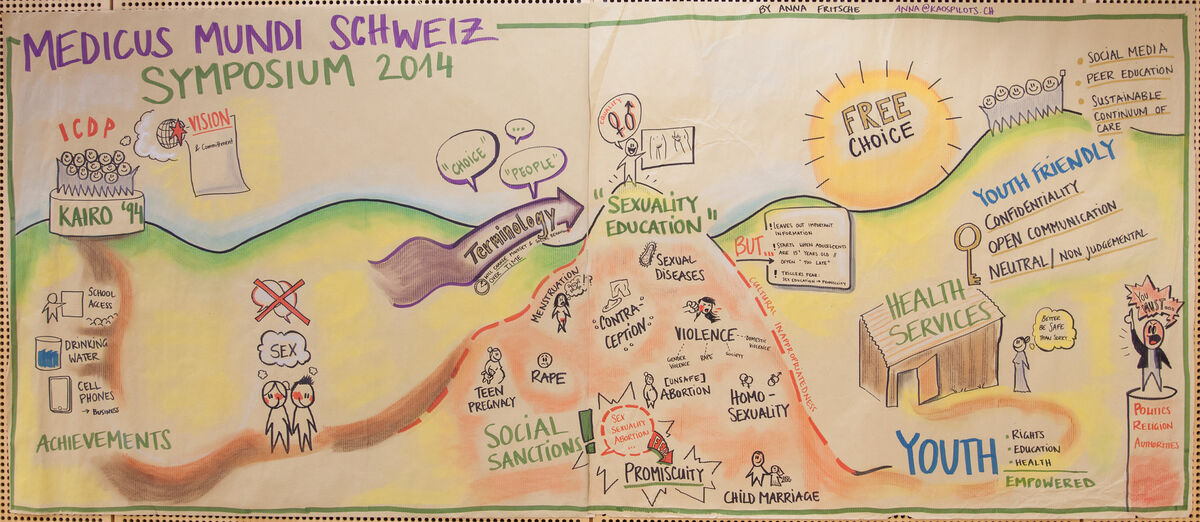Drawing by Anna Fritsche (anna@kaospilots.ch)
Adolescent’s health is far more than sexuality. During the transition from childhood to adulthood, adolescents establish patterns of behavior and make lifestyle choices that affect both their current and future health. Serious health and safety issues such as motor vehicle crashes, violence, substance use, and risky sexual behaviors can adversely affect adolescent and young adults.
Adolescent’s health – let’s talk about sex
There are strong public health, human rights and economic reasons on why to invest into young people’s sexual and reproductive health. The Cairo Programme of Action adopted in 1994 has significantly contributed to tangible progress but not everyone has been reached equally.
Still today
- about 16 million girls aged 15 to 19 and some 1 million girls under 15 give birth every year—most in low- and middle-income countries;
- pregnancy and childbirth are the leading cause of death among 15-19 year olds in low- and middle-income countries;
- every year, some 3 million girls aged 15 to 19 undergo unsafe abortions;
- adolescent birth rates are highest in poor countries, and in all countries they are clustered among the poorest and least educated;
- despite progress, in 2009 young people aged 15-24 years accounted for approximately 41% of new HIV infections worldwide;
- only 54% of countries in the Africa region address the issue of ensuring access of adolescents and youth to sexual and reproductive health information and services that warrant and respect privacy, confidentiality and informed consent, compared with 96%, 90% and 80% of countries in the Americas, Europe and Asia.

Drawing by Anna Fritsche (anna@kaospilots.ch)
Medicus Mundi Switzerland was invited to be part of the panel discussion on 15 December 2014 when WHO launched a Special supplement to the Journal of Adolescent Health: Twenty Years After International Conference on Population and Development: Where Are We With Adolescent Sexual and Reproductive Health and Rights?
Better and more evidence is need
The Special Supplement maps the progress made on adolescents sexual and reproductive health and rights in the twenty years since the landmark ICPD conference in 1994 and sets out implications for action and research, in five inter-related areas:
- creating an enabling environment
- providing comprehensive sexuality education
- providing sexual and reproductive health services and creating demand for their use
- preventing intimate partner violence and sexual violence
- promoting youth participation and leadership
Medicus Mundi Switzerland took the opportunity to emphasis key conclusions discussed by various experts during the MMS Symposium „Not without us!“. For example, adolescent living with HIV/AIDS face major barriers accessing treatment tailored to their needs. Problematic laws and policies including parental consent laws hinder adolescents reaching HIV testing and counselling services. They also face more often stigmatisation and discrimination. Our symposium on adolescent health highlighted the need for youth friendly health services (YFHS). Besides having a health facility which is appealing to young people with flexible opening hours, specific times for adolescents, which ensures privacy and confidentiality it needs skilled health professionals: special competencies are required to communicate with and treat adolescents.

Drawing by Anna Fritsche (anna@kaospilots.ch)
Health facilities need to be linked with the community. Young people need to know where to go, they need to know that their health problem is taken care off, that they are not stigmatised neither by the health care provider or the community when seeking care for e.g. post-abortion care, HIV testing and counselling or other sexual health matters.
Linking the community with youth friendly health services also means sensitising community leaders, religious leaders, parents, neighbours, and teachers on the topic of adolescents health and the right to access information on sexuality and reproductive health.
Our partners also talked about how sensitive the topic of sexuality is and how difficult it is to include and implement sexual health and sexuality education into national guidelines, policies and programs. Also in Switzerland comprehensive sexuality education is a hot topic and creates a lot of emotions in politicians, parents and teachers.
It is undeniable that the results of Cairo Conference in 1994 are still of utmost importance to international health cooperation. Adolescent sexual and reproductive health and rights need to remain high on the political agenda.
References
Promoting and protecting the sexual and reproductive health and rights of adolescents and young people. Twenty years on since the International Conference on Population and Development. http://www.who.int/reproductivehealth/topics/adolescence/journal-supplement/en/
Special Supplement of the Journal of Adolescent Health, published online on 18 December 2014. http://www.jahonline.org/issue/S1054-139X(14)X0004-2
68th WHA – WHO, 10 April 2015. Adolescent health – Report by the Secretariat. http://apps.who.int/gb/ebwha/pdf_files/WHA68/A68_15-en.pdf




